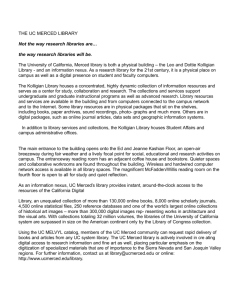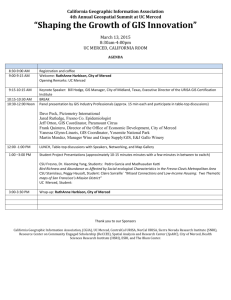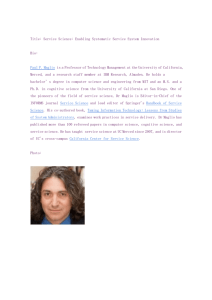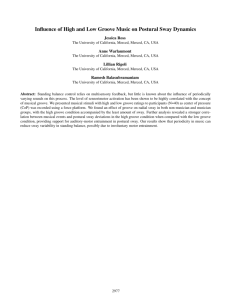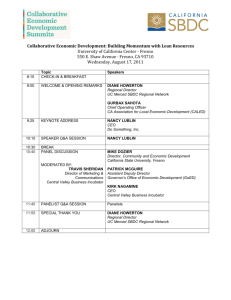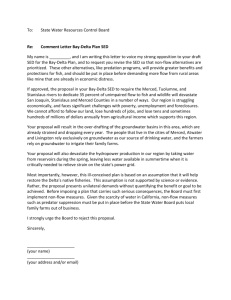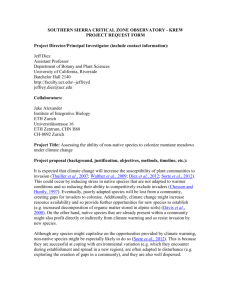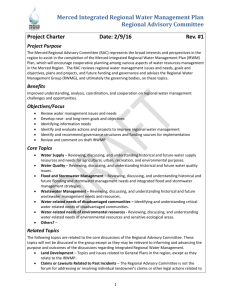LEADERSHIP
advertisement
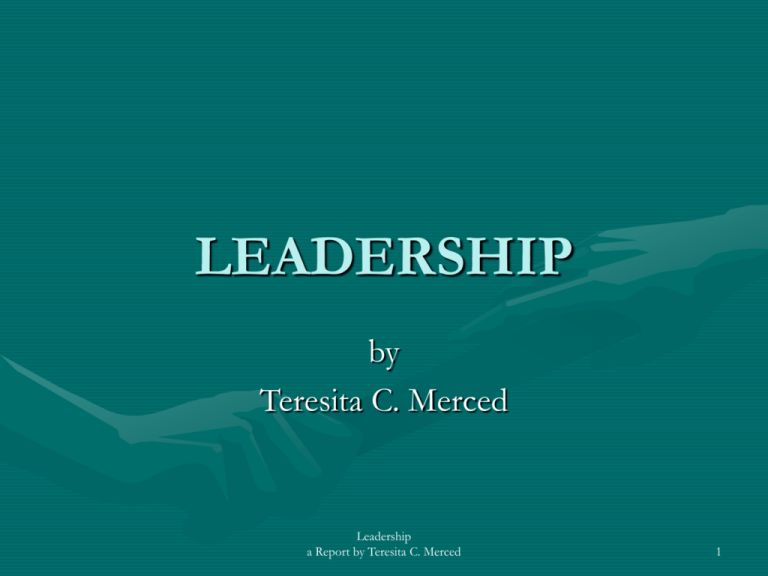
LEADERSHIP by Teresita C. Merced Leadership a Report by Teresita C. Merced 1 Order of Presentation • • • • • • • • Leadership and “Doing the Right Things” Leadership and Values What are Values? How do Values Develop? Identify and Live Your Personal Values Why Identify and Establish Your Values? Core Values Excellence in All We Do Leadership a Report by Teresita C. Merced 2 Order of Presentation • • • • • • • Leadership : the Key to Cultural Transformation Values-Based Leadership Characteristics of Values-Based Leadership Treat People With Dignity and Respect How Values Impact Leadership? Leadership and Organizational Values Build an Organization Based on Values Leadership a Report by Teresita C. Merced 3 Leadership and “Doing the Right Things” • Gardner (1990) and Burns (1978) stressed the centrality and importance of the moral dimension of leadership • Gardner said leaders ultimately must be judged on the basis of a framework of values, not just effectiveness • Burns (1978) maintains that leaders who do not behave ethically do not demonstrate true leadership. Leadership a Report by Teresita C. Merced 4 Leadership and“Doing the Right Things” • • • • • Bennis and Goldsmith (1997) describe four qualities of leadership that engender trust : vision, empathy, consistency, and integrity. Vision – leaders pull people together on the basis of shared beliefs and a common sense of organizational purpose and belonging Empathy - understand the world as we see and experienced it. Consistency - changes are understood as a process of evolution in light of relevant new evidence. Integrity – leader who demonstrates commitment to higher principles through their actions. Leadership a Report by Teresita C. Merced 5 Leadership and Values • Peter Drucker and Warren Bennis, 2 most respected names in business, leadership is doing the right things; management is doing things right. • In other words, leadership - doing the right things” is deciding the best course of action to take. • Once the best course or direction has been decided, management - doing things right” picks up the ball, looks at the objectives established by leadership Leadership a Report by Teresita C. Merced 6 What are Values? • Are “constructs representing generalized behaviors or states of affairs that are considered by the individual to be important” (Gordon, 1975 p.2) • Patrick Henry’s “Give me liberty, or give me death” expresses the value he placed upon political freedom. • Values may be terminal and instrumental. • Terminal values refer to desired end states while instrumental values refer to modes of behavior (Rokeach 1973). Leadership a Report by Teresita C. Merced 7 Terminal Values • • • • • • An exciting life A sense of accomplishment Family security Inner harmony Social recognition Friendship Leadership a Report by Teresita C. Merced 8 Instrumental Values • • • • • • Being courageous Being helpful Being honest Being imaginative Being logical Being responsible Leadership a Report by Teresita C. Merced 9 How Values Develop? Parents Religion Peers Personal Value System Technology Media Education Leadership a Report by Teresita C. Merced 10 How Values Develop? Skills / Comptetencies Knowledge Intelligence Experience Personality Traits and Preferences Leadership a Report by Teresita C. Merced Values / Interests 11 Identify and Live Your Personal Values • Values are traits or qualities that are considered worthwhile; they represent your highest priorities and deeply held driving forces • Value statements are grounded in values and define how people want to behave with each other in an organization, an institution, a company, or a family. They are statements about how the organization will value customers, suppliers, and the internal community. Leadership a Report by Teresita C. Merced 12 Examples of Values • ambition, competency, individuality, equality, integrity, service, responsibility, accuracy, respect, dedication, diversity, improvement, enjoyment/fun, loyalty, credibility, honesty, innovativeness, teamwork, excellence, accountability, empowerment, quality, efficiency, dignity, collaboration, stewardship, empathy, accomplishment, courage, wisdom, independence, security, challenge, influence, learning, compassion, friendliness, discipline/order, generosity, persistency, optimism, dependability, flexibility Leadership a Report by Teresita C. Merced 13 Why Identify and Establish Your Values? • You demonstrate and model your values in action in your personal and work behaviors, decision making, contribution, and interpersonal interaction. • You use your values to make decisions about priorities in your daily work and home life. • Your goals and life purpose are grounded in your values. Leadership a Report by Teresita C. Merced 14 Core Values • Integrity, First - the bedrock of any leader's character; describes one's ability to adhere to the highest set of standards and values; "moral compass" that allows us to do what is right even when no one is looking. Once you lose your integrity it's hard to earn back, but as long as you maintain it, nobody can take it from you. Everything we do starts with integrity. Leadership a Report by Teresita C. Merced 15 Core Values • Trust. We earn the trust of our co-workers, customers, leaders, and followers through a pattern of unquestioned integrity. When we lose our integrity, the trust we built is lost. • Courage. A leader of integrity possesses moral courage and does what is right even when the personal cost is high. Doing the right thing is sometimes harder, but is always worth the effort. • Honesty. Honesty must be our hallmark. Our word must be our bond. Honest people don't pencil-whip reports, don't cover up safety violations, and don't falsify documents. The bottom line is leaders of an honest organization do not lie, even in the face of negative consequences. Leadership a Report by Teresita C. Merced 16 Core Values • Responsibility. Leaders acknowledge their responsibilities during failure as they do during success. True character is displayed when times get tough as well as during times of glory. • Accountability. No leader shifts blame or takes credit for the work of others. Integrity equates to accepting the consequences of our actions, no matter how extreme they may be. • Justice. A leader practices justice. Those who do similar things must get similar rewards or similar corrective actions. • Feedback. Free flow of information within the organization. Feedback from all directions is possible in an environment where integrity has built an atmosphere of trust. Leadership a Report by Teresita C. Merced 17 Core Values • Respect. Respect everyone as human beings, the rules that govern our activities, and respect the systems that make up our organization. Also includes selfrespect. A leader of integrity does not behave in ways that would bring discredit upon them or the organization to which they belong. • Humility. A leader grasps the importance of responsibilities, but also realizes they are only one part of a larger system. • Group Integrity. Leaders conduct themselves in a forthright and candid manner, use their abilities to influence and build support and commitment from others by giving and receiving information effectively and efficiently. Leadership a Report by Teresita C. Merced 18 Excellence in All We Do • Product and Service Excellence. Values-based leaders focus on providing products that fully respond to customer wants along with anticipating customer needs. • Operations and Resources Excellence. Leaders aggressively implement policies and procedures to ensure the best possible management of their organization's crucial resources. Involves a commitment to total team effort, and a quest for continuous improvement. • Personal Excellence. Leaders seek out avenues for personal growth. Opportunities for self-improvement include actively participating in training programs, continually refreshing their educational backgrounds, and seeking feedback on their performance. Valuesbased leaders also encourage the personal growth of their Leadership employees. a Report by Teresita C. Merced 19 Excellence in All We Do • Human Resources Excellence. Leaders recruit, train, promote, and retain those who will do the best job for their organization. • Safety Excellence. Leaders demand that their employees work not only in a safe manner, but also ensure they are provided with a safe working environment. • Sense of Urgency and Initiative. Leaders display a sense of professional enthusiasm by working beyond money or status, and a propensity to pursue goals with energy and persistence. Leaders initiate actions and make decisions in a timely manner, avoiding excessive delays associated with over analyzing a situation. Leadership a Report by Teresita C. Merced 20 Leadership : Key to Cultural Transformation • Cultural transformation or whole system change cannot occur without a change in the behaviors of the leaders. • Organizations begin by mapping the values of the senior executives before they map the values of employees Leadership a Report by Teresita C. Merced 21 Leadership and Shareholder Value • Fact 1: Employee fulfillment drives customer satisfaction. • Fact 2: Customer satisfaction drives shareholder value. • Fact 3: Leadership development drives employee fulfillment. • Fact 4: Cultural alignment can occur at any level of consciousness, but only full spectrum consciousness creates sustainable high performance and long-term resilience. • Fact 5: Achieving full-spectrum organizational consciousness requires full-spectrum leaders. Leadership a Report by Teresita C. Merced 22 Values-Based Leadership • Values are becoming the preferred mode of decision-making in business. • It is not surprising therefore to find ample research showing that adaptable and values-driven companies are the most successful organizations on the planet. • When organizations unite around a shared set of values, they become more flexible, less hierarchical, less bureaucratic, and they develop an enhanced capacity for collective action. • Shared values build trust, and trust is the glue that enhances performance. Leadership a Report by Teresita C. Merced 23 Characteristics of Values-Based Leadership • A strong desire to do right, to do the best, and to treat others as they would like to be treated. • Values are not imposed, rather, selected. Values-Based leaders have critically examined these values and made a conscious decision to live by them. • Values guide leaders in a way of living that feels good (and right) after the fact. • Values-Based leaders expect good consequences if they embrace and live these values and bad consequences if they reject and don't follow them. • Help leaders be their best. Leadership a Report by Teresita C. Merced 24 Treat People With Dignity & Respect • Respect for Others. Appreciates the fundamental worth of all people as human beings. • Control of Emotions. Expects all members of their organization to refrain from displaying inappropriate emotions in such a way that would bring discredit upon themselves and/or their organization. • Acceptance of Diversity. Not only accepts diversity as a given, but also build off its strengths. • Leadership a Report by Teresita C. Merced 25 Treat People With Dignity & Respect • Self-Control. Ensures employees refrain from improper behaviors that cause hurt, anger, and frustration in others, inappropriate jokes, sexual advances, and racial or religious intolerance are unacceptable and undermine strong workplaces. • Feedback. Employees are provided with the proper feedback for personal excellence. Employees deserve honest feedback and most will be deeply appreciative of it. Leadership a Report by Teresita C. Merced 26 How Values Impact Leadership • Values play a key role in the choices made by leaders (Curphy,2003; England & Lee, 1974) • Leaders with strong Commercial values focus on financial results and shortcomings; those with strong Aesthetic values are more likely to review quality indicators. • Values also affect the solutions generated and the decisions made about problems. Leadership a Report by Teresita C. Merced 27 How Values Impact Leadership • Leaders with a strong Recognition value, might likely choose a riskier solution that would thrust them in the spotlight. • Values often influence a leader’s perceptions of individual and organizational successes as well as the manner in which these successes are achieved. • Leaders with strong Science values will define organizational success differently than those with strong Power values. Leadership a Report by Teresita C. Merced 28 Leadership & Organizational Values • Just as there are personal values, organizations also have organizational values representing the principals by which employees get work done and treat other employees, customers, and vendors. • Whether values truly represent operating principals or so much spin for potential investors will depend on the degree of alignment between the organization’s stated values and the collective values of top leadership (Hogan &Hogan, 1996; Hogan & Curphy, 2004). Leadership a Report by Teresita C. Merced 29 Leadership & Organizational Values • Top leadership’s collective values play a significant role in determining organizational culture. • Research shows that employees with values similar to the organization or team are more satisfied and likely to stay; those with dissimilar values are more likely to leave (Hogan & Hogan, 1996; Hogan & Curphy, 2004). • One reason why leaders fail is due to a misalignment between personal and organizational values. Leadership a Report by Teresita C. Merced 30 Leadership & Organizational Values • Covey (1990) developed and popularized an approach called principle-centered leadership. • Personal, the first imperative is to be a trustworthy person that depends on both one’s character and competence. • Leading a high-performing group depends on skills such as team building, delegation, communication, negotiation, and self-management. • An organization will be most creative and productive when its structure, systems (e.g. training, communication, and reward), strategy, and vision are aligned and mutually supportive. Put differently, certain organizational alignments are more likely to nurture and reinforce ethical behavior among its members than others. Leadership a Report by Teresita C. Merced 31
